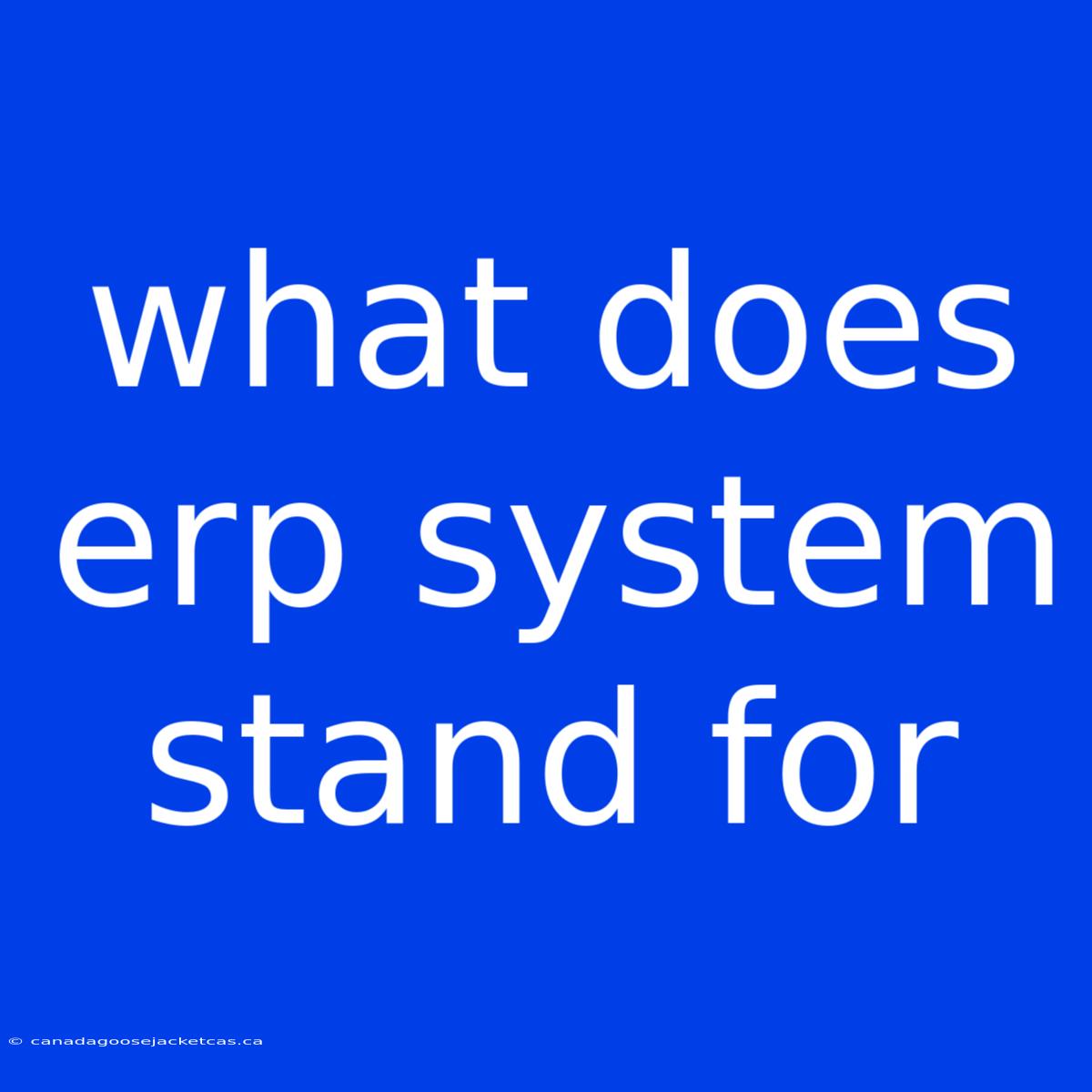What Does ERP System Stand For? Unlocking the Secrets of Enterprise Resource Planning
What does ERP system stand for? ERP stands for Enterprise Resource Planning. It's a powerful software suite designed to integrate and manage all aspects of an organization's operations.
Why is this important to read? Understanding ERP systems is crucial for businesses of all sizes. This technology can streamline operations, optimize resource allocation, and boost profitability. This article delves into the core concepts of ERP systems, helping you navigate the complexities of this transformative technology.
Our analysis involves researching numerous sources, consulting industry experts, and distilling complex information into a digestible format. This guide provides a comprehensive overview of ERP systems, enabling you to make informed decisions regarding its implementation.
Key aspects of ERP systems:
| Key Aspect | Description |
|---|---|
| Integration | Connects various business functions, eliminating data silos. |
| Automation | Streamlines repetitive tasks, improving efficiency and reducing errors. |
| Real-time Data | Provides a centralized view of operations, enabling better decision-making. |
| Scalability | Adapts to evolving business needs, growing with the organization. |
What is an ERP System?
An ERP system is a software solution that integrates various business processes, including:
- Financial Management: Tracking finances, managing budgets, and generating reports.
- Human Resources: Managing employee information, payroll, and benefits.
- Supply Chain Management: Tracking inventory, managing orders, and optimizing logistics.
- Customer Relationship Management (CRM): Managing customer interactions, improving service, and driving sales.
- Production and Operations: Planning and scheduling production, managing assets, and controlling quality.
Why Are ERP Systems Important?
ERP systems offer numerous benefits to organizations:
- Improved efficiency: Automating processes reduces manual effort and improves overall productivity.
- Enhanced decision-making: Real-time data provides insights for strategic planning and informed decisions.
- Increased profitability: Optimized resource allocation and reduced costs lead to higher profit margins.
- Better customer service: Streamlined operations improve response times and enhance customer satisfaction.
- Reduced risk: Centralized data management helps identify and mitigate potential risks.
Key Aspects of ERP Systems
Integration: Connecting the Dots
Integration is a core principle of ERP systems. By connecting different departments and functions, they eliminate data silos and provide a holistic view of business operations. This fosters collaboration, improves communication, and streamlines information flow.
Automation: Freeing Up Time and Resources
Automation is another key aspect of ERP systems. By automating repetitive tasks, ERP systems free up time and resources for more strategic initiatives. This can lead to significant efficiency gains, reduced errors, and improved accuracy.
Real-time Data: Making Data-Driven Decisions
ERP systems provide real-time data on key business metrics, enabling managers to make informed decisions. This dynamic view of operations helps identify trends, track performance, and react quickly to changing market conditions.
Scalability: Adapting to Growth and Change
Scalability is crucial for businesses that are growing or undergoing significant changes. ERP systems can be customized to meet evolving needs, accommodating new processes, expanding operations, and adapting to changing market dynamics.
Conclusion
ERP systems have revolutionized the way businesses operate, offering a comprehensive solution for managing complex operations. By integrating different business functions, automating processes, providing real-time data, and offering scalability, ERP systems empower organizations to achieve greater efficiency, profitability, and growth.
As technology continues to evolve, ERP systems will become even more sophisticated, providing businesses with even more powerful tools for success.
FAQ
What are the different types of ERP systems?
There are various types of ERP systems, each tailored to specific industries and needs. Some common categories include:
- Cloud-based ERP: Hosted on a cloud server, offering flexibility and affordability.
- On-premise ERP: Installed and maintained on the company's own servers, providing greater control.
- Industry-specific ERP: Designed for specific industries, offering tailored features and functionalities.
How much does an ERP system cost?
The cost of an ERP system can vary greatly depending on factors like the size of the company, the complexity of the implementation, and the chosen vendor.
What are the challenges of implementing an ERP system?
Implementing an ERP system can be a complex process, presenting challenges such as:
- Change management: Overcoming resistance to change and ensuring user adoption.
- Data migration: Moving data from legacy systems to the new ERP platform.
- Integration with existing systems: Connecting the ERP system with other software solutions.
- Training and support: Providing adequate training and ongoing support to users.
What are the best practices for choosing an ERP system?
Here are some best practices for selecting an ERP system:
- Define your business requirements: Clearly identify the specific needs and objectives for the ERP system.
- Research and compare vendors: Explore different ERP vendors and their offerings, considering features, functionalities, and costs.
- Seek expert advice: Consult with industry experts or consultants to get insights and guidance.
- Consider the long-term impact: Evaluate the system's scalability and ability to adapt to future needs.
Tips for Implementing an ERP System
- Engage stakeholders early: Involve key stakeholders in the planning and implementation process to ensure buy-in and support.
- Develop a clear project plan: Define project scope, timelines, milestones, and resources.
- Provide adequate training: Ensure users are properly trained on the new system to maximize adoption.
- Communicate effectively: Keep stakeholders informed about progress, challenges, and solutions.
- Monitor and evaluate performance: Regularly track key metrics to assess the effectiveness of the ERP system.
Summary
This article provided an overview of ERP systems, exploring their definition, importance, and key aspects. We discussed the benefits of ERP systems, including improved efficiency, enhanced decision-making, and increased profitability. We also highlighted the challenges of implementation and provided tips for successful adoption.
By understanding the power and potential of ERP systems, businesses can make informed decisions regarding their implementation and unlock a world of possibilities for growth and success.

